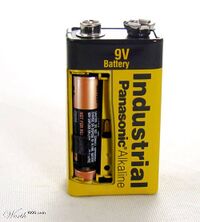Battery
“♪♪ Smashing through the boundaries, / Lunacy has found me. / Cannot stop the battery! ♪♪”
A battery is an animal that stores electricity. (The technical term is juice.) When such an animal becomes rabid and attacks people, that too is battery.
Two facts show that batteries are often rabid:
- When you need them the most, they are the most likely to have no juice.
- When you think you know the battery's age and how long it should hold juice, it is always older than it was when you acquired that opinion, and therefore runs out of juice earlier than expected.
Batteries originally just battered people, but eventually started to store electricity to shock people and then batter people. They are also incredibly dramatic. They do not merely run out of juice — they die.
Sizing up batteries[edit]
Voltage[edit]
As "Street Cred" is how some delinquents judge themselves against one another, the pecking order of batteries is the volt. The higher a battery's voltage, the more powerful a battering its victim can expect. A 1.5-volt battery can barely injure at all. Higher-voltage batteries such as 9-volt batteries should be approached with caution. Their voltage can be tested by the tongue. Twelve volts is more painful, causing electrical burns and bruises. To test a 12 volt battery, connect a needle to both ends of the battery and poke one into each arm.
The highest known combined voltage is 250 volts. Though extremely lethal, this only occurs when wired directly to genitals in a fantasy created by John Kerry during testimony before the U.S. Congress.
Medieval inventor Van DeGraaff had a more fertile imagination, envisaging a "generator" that could batter at tens of thousands of volts. Unfortunately, his prototype obviously only attracted evil spirits. Don King's hairstyle is the most famous result of battery from this machine.
Current[edit]
A battery with high voltage is dangerous only sometimes. The true peril occurs when these sociopaths become "amped up." Amperage is the measure of this dangerousness, though again, Parole Commissions that hear a seemingly heartfelt "expression of remorse" often let an amped-up battery go back to the docking station. Jurists often refer to a culprit being "in the dock," though it is now frowned-upon to lay into him using oars.
A popular measure of this danger is the milliamp-hour. To use the official metric abbreviation, this describes how much battering a culprit can deliver before the victim cries out for "mAh."
The mAh rating is crucial to battery advertising, particularly the metric prefix. Experts know you will pay more for a 7000 mAh battery than you would for a 7 Ah battery. The reader might be uttering "Ah" right now, but it is unlikely to change this sales pitch.
Sizing up size[edit]
In addition to nitpicky requirements for voltage and amperage, another creative way that gadget-makers frustrate the customer is by inventing a wide variety of battery sizes. Not only is it obviously impossible to fit a too-large battery into a radio's battery compartment (even with a high-quality hammer), it is also impossible to use a battery that is too small. And, unlike fuses, the battery cannot be replaced with a penny or other objects lying around the house.
Battery size is measured using a letter grade. Old-style, large batteries are called D cells. Newer, smaller batteries use preceding letters of the alphabet. It is a glimpse into the engineering mind that the system began at D rather than at Z. As batteries became even smaller, they had to go to AA and even AAA, just as Minor League Baseball does when it tries to exaggerate the quality of one of its leagues. The AAA cell is supposed to be a very small battery. However, if you have a hearing aid that requires an AAA cell, the only way to make it aesthetically pleasing is to paint it and pretend that it is an ear-ring.
Sociology of batteries[edit]
Batteries often run in packs. They are especially dangerous in such combinations. Large groups of batteries should be avoided at all costs. Indeed, Jesse Jackson has even admitted that, when he sees a pack of batteries approaching him on the sidewalk, he crosses the street (a move known as the "shunt").
Batteries may combine in serial or parallel. When walking along the gutter of a road that doesn't have a sidewalk, experts recommend serial, and facing oncoming traffic, or at least having all the positive terminals pointed in the same direction. But the most belligerent batteries walk in parallel. Even citizens who do not move to the other side of the street sometimes are forced off the curb to avoid a battery.
Rechargeables[edit]
Rechargeable batteries are a social problem because of their recidivism. Non-rechargeable batteries die after battering a person. However, because of our permissive society, Parole Commissions, Executive Clemency, and plug-in docking stations, a rechargeable battery that dies can undergo a type of reincarnation and go on to batter anew.
Just as any battery is older, and dies sooner, than expected, rechargeable batteries become incapable of recharging sooner than you think. In technical terms, a battery that dies and fails to take a new charge is dead.
In a fate worse than death, dead rechargeables that are dead are now declared "toxic waste." This scary term means you ought not to eat them — whole or grated and sprinked on a casserole. Another thing that is unacceptable is to put them out at the curb (without substantial concealment) or row to the middle of the lake and dump them in (except at night). You must take them to the Community Recycling Center and usually receive a lecture from a spinster on how your desire to listen to talk radio even though the lights were out all day yesterday is "killing the planet."
Defences[edit]
The only effective defence against batteries is called earthing. (In the U.S., it is called grounding because batteries in the hood are often booted out of the trunk onto the ground.) Earthing is done by the earth staff. They have written booklets of standards regarding good earthing practices. The earthstaff works like a earthstick, which is found near circuit boards. Persons not interested in jousting with batteries can simply deploy "decoupling capacitors" to dissipate the dangerous juice.
Salt permits a citizen who must be out late at night to actively defend against even a pack of batteries. It works by corroding the terminals. In many jurisdictions, however, the offensive use of salt needs a police permit, just as pepper spray does. Sadly, a bigger bureaucracy will never ensure the proper use of salt and pepper. Not even Michelle Obama can do that. When conflict occurs between a citizen and a battery pack, one or both is often charged with the felony of A Salt and Battery.




